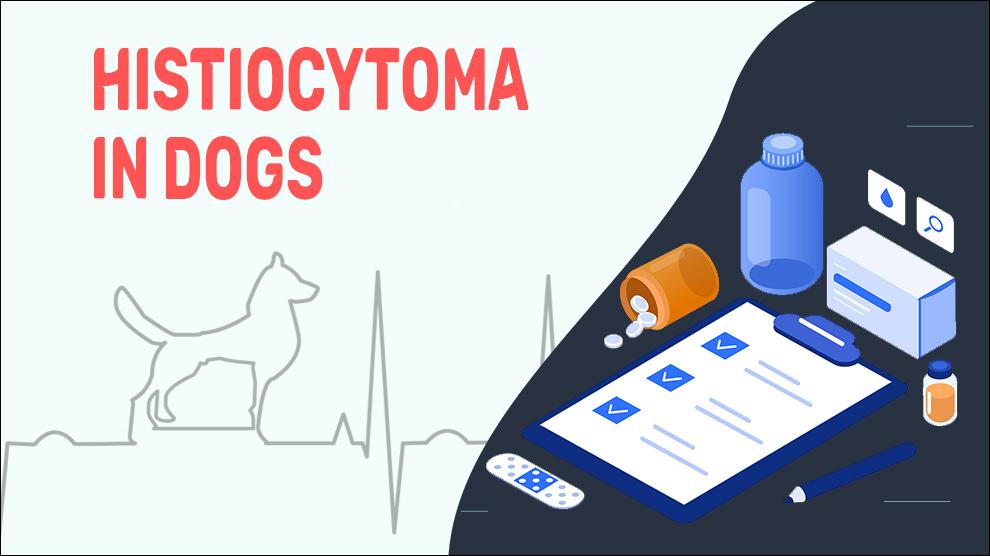What Is Histiocytoma In Dogs?
Canine Histiocytoma is a benign, pedunculated, or nodular neoplasm that arises from monocyte-macrophage cells in the skin. They are usually firm and well-circumscribed but sometimes, on palpation feel soft. The overlying hyperpigmented skin is keratotic or shiny and when the tumor is pinched, there is a depression on the surface.
Also called Dermatofibroma, progressive nodular histiocytoma is characterized by an extensive eruption of several deeper, larger subcutaneous, yellowish-brown papules (2- to 10 mm). Oral, laryngeal, and Conjunctival lesions may occur. The Dermatofibromas arise most frequently on the limbs and are usually asymptomatic but are pruritic occasionally. They are composed of histiocytes in varying proportions, young and mature collagen, fibroblasts, and capillaries, forming a nodule in the dermis that has poorly defined edges.
In general, Histiocytosis refers to an abnormally large amount of histiocytes. There are many different types of histiocytosis, A cutaneous histiocytoma is an abnormal histiocyte proliferation in cells of Langerhans. The first 1-4 weeks is a period of rapid growth. Histiocytes grow rapidly, they often ulcerate and get infected.
Histiocytes are derived from monocytes, a category of leukocytes that function as part of the immunological barrier against foreign organisms that would invade the skin. In the case of histiocytomas, the reproductive mechanism of these histiocytes which are self-regulatory becomes disarray.
Symptoms Of Histiocytoma In Dogs
- Nodular lesions
- Smooth /ulcerous/ hairless/crusted lesions
- Lesions in mucous membranes, nose, eyelids, extremities, and scrotum
- Purpura
- Oedema
- Crusting/ Scaling
- Erosions
- Hyperpigmentation
Treatment Options For Histiocytoma In Dogs
Treatment is not necessary for most histiocytoma. However, rarely does histiocytoma get large or infected and cause discomfort or other symptoms, then medications can be given
Broad-spectrum antibiotics. All the dosage information is anecdotal.
Amoxicillin – Amoxil, Amoxi-Drops, Bimox, Robamox Novamoxin.
Sometimes, an Antibiotic combo (Amoxicillin/Clavulanate) is used.
Cefpodoxime - Vantin and Simplicef, FDA approved for dogs only (2.5 to 5 milligram/pound).
Cefadroxil - Duricef/Cefa-Drops/ Cefa-Tabs (10 - 15 mg/lb every 12 hours).
Cefovecin - Convenia (8 mg/kg or 3.6 mg/lb, SC).
Ormetoprim-sulfadimethoxine - SID for 7 -23 days (11 mg/kg ormetoprim and 55 mg/kg sulfadimethoxine).
Home Remedies For Histiocytoma In Dogs
Histiocytoma can regress completely even with medical management. Discuss home treatments with your vet to ensure there won’t mess with other medications.
Follicle flushing- Clean the dirty hair follicles using medicated shampoos.
Green Tea Apple Cider Vinegar (ACV) or nettle Aloe Vera can be applied.
How To Prevent Histiocytoma In Dogs?
Prevention is not possible for histiocytomas as the causes are still unknown.
Good overall health and early detection are the only ways to prevent histiocytoma.
Keep an eye on your dog and consult your veterinarian right away if you find any odd rashes or lumps.
Affected Dog Breeds Of Histiocytoma
Shar Pei, Labrador Retriever, Boxer, Bulldog, American Pit Bull Terrier, American Staffordshire Terrier, Scottish Terrier, Greyhound, Boston Terrier, Young Dogs, Bernese Mountain Dog, Briard, Bichon Frise, Collie, Golden Retriever, German Shepherd, Maltese, Pekingese, Poodle, Rottweiler, Silky Terrier
Causes And Diagnosis For Histiocytoma In Dogs
1. Causes:
- Mostly congenital/ idiopathic.
- Allergic skin diseases (e.g., flea allergy dermatitis, atopic dermatitis).
- Infections (bacterial, fungal, Viral -Coronavirus, Parvovirus).
- Exposure to herbicides, pesticides, and insecticides.
2. Mortality:
Histiocytoma is not a potentially life-threatening disease in dogs and the mortality rate of dogs is not documented.
3. Diagnosis:
- Routine hematology
- Urinalysis
- Surgical biopsy
- Histopathological examination of the skin
- Rickettsial screening
- Fungal culture
- Bacterial culture
4. Differential diagnosis:
- Angioedema
- Adverse cutaneous drug reaction
- Canine distemper
- Chin pyoderma
- Demodicosis
- Dermatophytosis
5. Prognosis:
Though histiocytomas are considered unsightly by most owners' standards, these masses are benign. Actually, if left untreated, they may regress spontaneously and resolve within two to three months or less. This autoimmune disorder may be predisposed in certain breeds. This condition can be painful to puppies but it looks as if they have pimples on their body.
When To See A Vet For Histiocytoma In Dogs?
Contact your vet right away, if you notice any of the following:
- Nodular lesions
- Smooth /ulcerous/ hairless/crusted lesions
- Lesions in mucous membranes, nose, eyelids, extremities, and scrotum
Food Suggestions For Histiocytoma In Dogs
- Low fat, high protein foods- Skinless, White-Meat Poultry, White-Fleshed Fish, Beans, Peas, and Lentils.
- Protein - liver ½ Cup, turkey breasts, chicken breasts, Raw Salmon (or cooked).
- Lean meats, such as chicken breast, pork, sirloin, etc.
- DHA-mackerel, herring, caviar, sardines and salmon.
- Antioxidants- blackberries, Blueberries, spinach, Steamed broccoli, kale, cooked yellow squash, green beans.
- Fats - beef tallow, Chicken/turkey fat.
Conclusion
In most cases, Histiocytoma resolves fully with appropriate treatment. Usually, one course of medication is sufficient to treat the condition. Recurrence of the condition is uncommon.
Sometimes, pruritic lesions develop around the eyes/eyelids; this may result in permanent scarring.

















